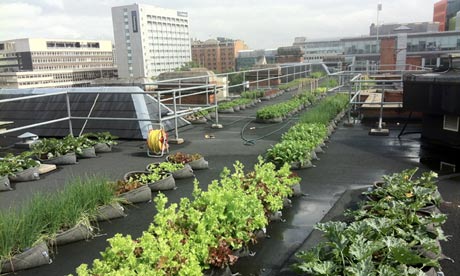
The edible roof garden on top of the Bloomsbury Street Hotel. Photograph: inmidtown
Via The Guardian, an article on how offices are increasingly turning their roofs into edible gardens and bee sanctuaries:

The edible roof garden on top of the Bloomsbury Street Hotel. Photograph: inmidtown
Green roofing – the practice of planting vegetation on a building’s roof or terrace – is the ultimate in urban landscaping, making the most of extremely limited space to bring a flash of greenery to a cityscape.
For inmidtown, the Business Improvement District for Bloomsbury, Holborn and St Giles, it’s about more than making London’s roofs easy on the eye though.
The business benefits are significant, yet largely untapped. From improved employee engagement and productivity; to reduced carbon emissions, green roofs could save businesses millions in energy costs. They can improve a property’s value too, and even reduce noise entering the building.
The environmental benefits are just as clear. In addition to improving insulation and thereby reducing carbon emissions and energy costs, they’re an intelligent solution for businesses that hich want to adapt to climate change, which means that rainfall bursts will become shorter but more intensive, especially in summer.
Green roofs can help to contain flash flooding and improve the quality of water run-off, with Environment Agency research noting that both nitrogen and phosphorus can be reduced through green roofs. Furthermore, green roofs provide a habitat for wildlife, support the local environment by helping to lower urban air temperatures, and improve air quality. Growing fruit and vegetables, which can be used by businesses to supplement produce they buy, is the latest evolution of London’s green roofs.
As part of inmidtown’s bid to make the area London’s most sustainable commercial district, it recently launched two organic fruit and vegetable edible gardens across central London businesses. In addition to the host of environmental benefits already discussed, these gardens support hyper-local production of produce, and enable businesses to reduce the food miles associated with their usual orders, so offer yet another incentive.
The green roofs scheme is currently supported by organisations in the area such as law firm Olswang, and the Bloomsbury Street Hotel, which are growing edible roof gardens, whilst on a further two green roofs, law firm Mischon de Reya and the Trade Union Congress are growing wildflowers to support the local bee population
The Bloomsbury Street Hotel, before and after. Photograph: inmidtown .
The amount of upkeep needed for these roofs is minimal. The companies have established gardening clubs to maintain them, which are great for employee engagement too. Olswang’s gardening club not only ensures that employees can take a proper lunch break, but also that people from different areas of the business mix together. A gardening club offers an ideal, organic, opportunity for staff from all areas of the business to unite for a common goal.
Green roofs provide a good place to pop outside for a quick break for hard-working employees, and are also great for client entertainment. Olswang gave clients honey produced by its own bees last Christmas. The inmidtown Urban Bee Project encourages local businesses to give homes to hives and provide small areas of forage in the area for bees, another component to its bid to make the area London’s most sustainable commercial district.
The process of installing green roofs is streamlined, all the businesses involved in the scheme use pocket habitats, which are a series of small modular sacks filled with soil and planted. This is a far tidier, cheaper and quicker method than planting a full roof, and has the added benefit of providing form and structure to an area.
Each pocket habitat is an independent unit composed of variously textured and coloured recycled substrates and wildflower seed. The composite felt material is specifically engineered to optimise drainage to ensure plants do not become waterlogged. Drainage is a key function of green roofs – inmidtown’s project was partly funded by a £15,000 grant from Drain London, and the five roofs alone will re-use nearly 87,000l of rainwater.
Furthermore, pocket habitats can be tessellated to create mosaic that specifically allows for biodiversity. They are also easily portable, which is ideal for our roofs growing vegetables, as these can be seasonally harvested and then re-used.
Green roofs are a crucial development for London’s businesses, if we want to create and promote ourselves as a low-carbon city and a global leader in sustainability. Utilising the collective strength of its members, the inmidtown BID aims to establish an effective and practical model that can, and with any luck will, be replicated across the city.
You must be logged in to post a comment.